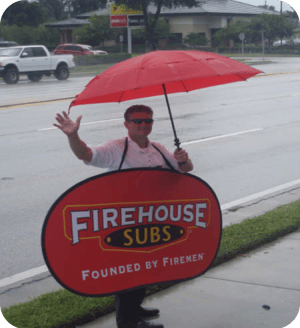CEO Blog - Advice for CEOs on growth and scaling
Buying Local: How Multi-Unit CEOs Can Win at Marketing in Anytown, U.S.A.

There was a time, generations ago, when buyers didn’t venture too far from their home to satisfy their basic needs. Today, most consumers don’t think twice about using a few keystrokes to get the necessities shipped from some distant warehouse to their front door.
Despite this phase shift, “buying local” remains a relevant concept, and even source of pride for communities that rally around the bricks-and-mortar businesses that still dot the landscape.
So, in the face of Amazonian-sized efforts to get consumers to do otherwise, how can you, as a multi-unit CEO, provide the necessary marketing support to your local units to keep the lifeblood flowing?
Local store marketing, or LSM, though not easy, isn’t really that hard. Once you commit to a strategy, the actual motions can be exceedingly easy. Nonetheless, LSM requires patience, commitment and resources; and execution can be time-consuming and tedious. And unlike online marketing, where data flows in both directions, many LSM efforts are still measured by feet (the human kind), and not 0s and 1s.
So, how do we define LSM, and what are some key considerations to foster success?
LSM – A Definition
First, let’s consider the following examples:
- A local restaurant drops off a catering menu to your office.
- You notice that a little league baseball team is sponsored by the local hardware store.
- You encounter three dry cleaners within a mile of where you live, each with a sign that promotes their price or extra benefits.
Of these, which would you consider to be LSM? If you answered “all,” you would be correct. Whether you know it as guerrilla marketing, shoe-leather marketing, neighborhood marketing or even just plain old “local marketing,” all of these fit the definition of LSM - marketing and advertising for a small business location to augment other national or regional marketing, IF the small business is part of a larger brick-and-mortar chain.
Lather, Rinse, and Repeat
To be effective, LSM has to be executed every week, all the time. Sponsoring a little league team once, or replying to online reviews twice per year, or buying an ad in the local shopper twice is what we at Chief Outsiders call “Random Acts of Marketing” – those sporadic and non-strategic one-offs that do little to move the needle.
To be truly successful, LSM needs to be a fixture of every local store’s marketing plan – in the words of Vince Lombardi, “it is not a sometime thing, it is an all the time thing.” The best way to make this happen is to commit resources to it as part of your overall marketing mix. Since it typically comprises but a small percentage of your chain’s overall marketing budget, it is built for endurance – not speed – so you need to be patient with the outcome.
Site Awareness is as Important as Brand Awareness
I’ll share a true story about an experience I had when I was at Firehouse Subs. The story takes place several years ago, when online reviews weren’t yet a big thing, and mobile didn’t have the pervasive influence that it does today.
It was at a time when Firehouse Subs had about 300-400 restaurants, and we determined that, without the air cover of regional or national advertising, we had to do something to jump-start sales and get franchisees engaged.
One way we did this was conducting “Founder’s Tours.” The co-founders, COO and many of the rest of the HQ staff went on bi-weekly road trips, known as Founder’s Tours. On one trip, we pulled up to a restaurant in central Florida and clamored out of the bus. There were 12 of us on the bus that day and when we arrived at the restaurant at around 9:30 a.m., we were given a map of neighborhoods and businesses to visit, and bags filled with catering menus, courtesy cards, cookies, and chips. Of course, one person had to remain behind to be the sign waver.
That’s right – the sign waver. That’s because the two primary LRM tactics we were modeling for the franchisee were:
- Neighborhood canvassing to get to know your neighbors
- Sign waving to draw attention to the location
While I waved a large sign with a Firehouse Subs logo on it, six teams of two people each went into the trade area and visited as many other local businesses as they could in about two hours. When everyone returned to the restaurant, we debriefed.
Here’s what we learned:
- Each team covered a distance of about ¾ - 1 mile from the restaurant
- Most businesses were happy to receive the “free” goodie bag
- About 75 percent had heard of Firehouse Subs (Brand awareness, yes!)
- Over half of those visited, did not know of the specific location of this restaurant
I’ll let that last bullet point sink in for a moment. Over 50 percent of the people we talked to within a mile of the restaurant had no idea they were less than a mile from the restaurant.
Had this been a new location, site awareness would have been expected to be low. Unfortunately, the business had been open and operating for more than 4 years at the time of the Founder’s Tour visit.
That’s when we realized that brand awareness is one thing, and site awareness is another. Having brand awareness without site awareness is worthless.
How can a small business let potential customers in their trade area know where it is located?
Be active in the community, get to know your neighbors -- and be visible.
In other words, commit to local marketing for your locations, and be found.
Topics: Successful Marketing Strategies, CEO Marketing Strategy, Brand Management
Wed, Jun 10, 2020Featured Chief Outsider
/cmo-Doug-Reifschneider.jpg?width=200&height=200&name=cmo-Doug-Reifschneider.jpg)
Doug Reifschneider
Related Articles

- Press Releases
- Careers
- Case Studies
- Marketing Consultant Company
- Marketing Strategy Consultants
- Marketing Plan Consultants
- B2B Marketing Consultants
- Virtual CMO
- Marketing Consultant Outsourcing
- Fractional CMO
- What is a Fractional CMO
- Healthcare Marketing Consultant
- Marketing Consultant Houston TX Texas
- Marketing Consultant Texas TX
- Marketing Consultant Bay Area
- CEO Blog
- Ebooks Plus
- Executive Marketing Consultants
- Product Marketing Consultants
- B2C Marketing Consultants
- Virtual Marketing Consultants
- Senior Marketing Consultants
- Temporary CMO
- Hire a CMO
- Fractional CMO Salary
- Fractional CMO Responsibilities
- Marketing Consultant Austin TX Texas
- Marketing Consultant Dallas TX Texas
- Marketing Consultant San Antonio
- Helping Private Equity
- Private Equity Blog
- Leadership Team
- Privacy Policy
- Business Marketing Consultants
- Strategic Marketing Consultants
- Marketing Technology Consultants
- Sales and Marketing Consultants
- CMO Job Description
- CMO Salary
- Fractional CMO Agency
- Fractional CMO Services
- CPG Marketing Consultant
- Marketing Consultant San Diego
- Partners
Houston, TX 77056
© 2023 Chief Outsiders

